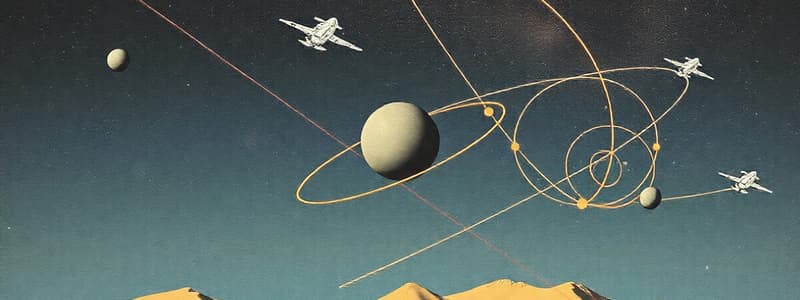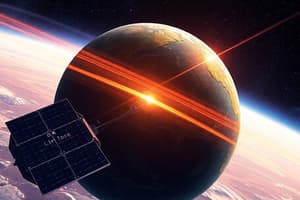Podcast
Questions and Answers
Which of the following is NOT true about comets?
Which of the following is NOT true about comets?
- They orbit the sun in elliptical paths.
- They are always visible in the night sky. (correct)
- Their orbit periods can vary greatly.
- They contain icy material.
What is the main reason a comet develops a tail when it approaches the Sun?
What is the main reason a comet develops a tail when it approaches the Sun?
- The comet's icy material vaporizes due to the heat. (correct)
- The comet's rotation causes its material to be flung off.
- Friction between the comet and the Sun's atmosphere creates heat.
- The Sun's gravity pulls the comet's material outward.
If an object has a mass of 25 kg, what is its weight on Earth?
If an object has a mass of 25 kg, what is its weight on Earth?
- 250 N (correct)
- 500 N
- 25 N
- 2500 N
You are standing on the Moon. Your mass is 60 kg. What is approximately your weight on the Moon?
You are standing on the Moon. Your mass is 60 kg. What is approximately your weight on the Moon?
What force keeps the Moon in orbit around the Earth?
What force keeps the Moon in orbit around the Earth?
If a satellite is moving too slowly in its orbit around Earth, what will happen?
If a satellite is moving too slowly in its orbit around Earth, what will happen?
Which of the following best describes the effect of gravity on an object?
Which of the following best describes the effect of gravity on an object?
What is the relationship between an object's mass and its gravitational pull?
What is the relationship between an object's mass and its gravitational pull?
What is the primary force responsible for keeping satellites in orbit around Earth?
What is the primary force responsible for keeping satellites in orbit around Earth?
How does the speed of a satellite in orbit relate to its distance from Earth?
How does the speed of a satellite in orbit relate to its distance from Earth?
What is the purpose of geostationary satellites?
What is the purpose of geostationary satellites?
Which type of satellite orbits are used for GPS navigation?
Which type of satellite orbits are used for GPS navigation?
What is the primary force that causes a nebula to collapse and form a protostar?
What is the primary force that causes a nebula to collapse and form a protostar?
What is the key characteristic that defines a main sequence star?
What is the key characteristic that defines a main sequence star?
Which of the following is NOT a characteristic of low Earth orbit satellites?
Which of the following is NOT a characteristic of low Earth orbit satellites?
What is the main reason why the cloud of gas and dust that formed our Solar System began to collapse?
What is the main reason why the cloud of gas and dust that formed our Solar System began to collapse?
What happens to a star like the Sun when it runs out of hydrogen fuel?
What happens to a star like the Sun when it runs out of hydrogen fuel?
Which of the following is NOT a stage in the life cycle of a star like the Sun?
Which of the following is NOT a stage in the life cycle of a star like the Sun?
What is the primary element formed when hydrogen nuclei fuse together in a star?
What is the primary element formed when hydrogen nuclei fuse together in a star?
What is the primary reason for the increase in temperature within a star's core?
What is the primary reason for the increase in temperature within a star's core?
What is the main difference between the orbits of planets and artificial satellites?
What is the main difference between the orbits of planets and artificial satellites?
How does the formation of planets relate to the formation of stars?
How does the formation of planets relate to the formation of stars?
What is the ultimate fate of a star like the Sun after it has become a red giant?
What is the ultimate fate of a star like the Sun after it has become a red giant?
Which force is responsible for balancing the outward pressure from fusion in a main sequence star?
Which force is responsible for balancing the outward pressure from fusion in a main sequence star?
What does the red-shift of light from distant galaxies indicate?
What does the red-shift of light from distant galaxies indicate?
What is the approximate temperature of the cosmic microwave background radiation (CMBR)?
What is the approximate temperature of the cosmic microwave background radiation (CMBR)?
What does the Big Bang theory predict about the relationship between the distance of a galaxy and its speed?
What does the Big Bang theory predict about the relationship between the distance of a galaxy and its speed?
How long does it take light from the Sun to reach Earth?
How long does it take light from the Sun to reach Earth?
When we observe distant stars, what are we actually seeing?
When we observe distant stars, what are we actually seeing?
What happens when all the nuclear reactions in a small star, like the Sun, are over?
What happens when all the nuclear reactions in a small star, like the Sun, are over?
What is the key difference between a white dwarf and a neutron star or black hole?
What is the key difference between a white dwarf and a neutron star or black hole?
What causes the phenomenon of red-shift in the light from distant galaxies?
What causes the phenomenon of red-shift in the light from distant galaxies?
How does the red-shift of light from a galaxy relate to its speed?
How does the red-shift of light from a galaxy relate to its speed?
What evidence supports the idea that the Universe is expanding?
What evidence supports the idea that the Universe is expanding?
What does the Big Bang theory explain?
What does the Big Bang theory explain?
What is NOT a piece of evidence supporting the Big Bang theory?
What is NOT a piece of evidence supporting the Big Bang theory?
What is the significance of the dark lines in the emission spectrum of light from stars?
What is the significance of the dark lines in the emission spectrum of light from stars?
Which of the following is NOT a characteristic of a planet?
Which of the following is NOT a characteristic of a planet?
Which of the following is TRUE about the relationship between a planet's distance from the Sun and its orbital period?
Which of the following is TRUE about the relationship between a planet's distance from the Sun and its orbital period?
Why was Pluto reclassified from a planet to a dwarf planet in 2006?
Why was Pluto reclassified from a planet to a dwarf planet in 2006?
Which of the following statements accurately describes our Solar System?
Which of the following statements accurately describes our Solar System?
Why is the temperature on Mercury so high compared to Neptune?
Why is the temperature on Mercury so high compared to Neptune?
Which of the following is NOT found in the Solar System?
Which of the following is NOT found in the Solar System?
What is the primary reason why a planet's gravitational field is stronger than that of a dwarf planet?
What is the primary reason why a planet's gravitational field is stronger than that of a dwarf planet?
What is the main difference between a planet and a dwarf planet?
What is the main difference between a planet and a dwarf planet?
Flashcards
Comet
Comet
A small object made of ice, dust, and rock that orbits the Sun.
Orbit
Orbit
The curved path of an object around a star, planet, or moon due to gravity.
Gravity
Gravity
A force that attracts objects towards one another; larger mass means stronger pull.
Mass vs Weight
Mass vs Weight
Signup and view all the flashcards
Weight Calculation
Weight Calculation
Signup and view all the flashcards
Elliptical Orbits
Elliptical Orbits
Signup and view all the flashcards
Effects of Gravity
Effects of Gravity
Signup and view all the flashcards
Stable Orbit Conditions
Stable Orbit Conditions
Signup and view all the flashcards
Milky Way Galaxy
Milky Way Galaxy
Signup and view all the flashcards
Sun
Sun
Signup and view all the flashcards
Geocentric model
Geocentric model
Signup and view all the flashcards
Heliocentric model
Heliocentric model
Signup and view all the flashcards
Planets
Planets
Signup and view all the flashcards
Dwarf planets
Dwarf planets
Signup and view all the flashcards
Asteroids
Asteroids
Signup and view all the flashcards
Moons
Moons
Signup and view all the flashcards
Centripetal Force
Centripetal Force
Signup and view all the flashcards
Gravitational Attraction
Gravitational Attraction
Signup and view all the flashcards
Geostationary Orbit
Geostationary Orbit
Signup and view all the flashcards
Medium Earth Orbit
Medium Earth Orbit
Signup and view all the flashcards
Low Earth Orbit (LEO)
Low Earth Orbit (LEO)
Signup and view all the flashcards
Star Formation
Star Formation
Signup and view all the flashcards
Nebula
Nebula
Signup and view all the flashcards
Fusion Process
Fusion Process
Signup and view all the flashcards
Red-shift
Red-shift
Signup and view all the flashcards
Cosmic Microwave Background Radiation (CMBR)
Cosmic Microwave Background Radiation (CMBR)
Signup and view all the flashcards
Big Bang theory
Big Bang theory
Signup and view all the flashcards
Light-year
Light-year
Signup and view all the flashcards
Looking into the past
Looking into the past
Signup and view all the flashcards
Nuclear Fusion
Nuclear Fusion
Signup and view all the flashcards
Protostar
Protostar
Signup and view all the flashcards
Main Sequence Star
Main Sequence Star
Signup and view all the flashcards
Red Giant Star
Red Giant Star
Signup and view all the flashcards
Supernova
Supernova
Signup and view all the flashcards
Neutron Star
Neutron Star
Signup and view all the flashcards
Black Hole
Black Hole
Signup and view all the flashcards
White Dwarf
White Dwarf
Signup and view all the flashcards
Expansion of the Universe
Expansion of the Universe
Signup and view all the flashcards
Galactic Distance and Red-Shift
Galactic Distance and Red-Shift
Signup and view all the flashcards
Study Notes
The Solar System
-
Our Solar System is located in the Milky Way galaxy, along with billions of other stars.
-
The Sun is the largest object in our Solar System.
-
The Sun's gravity keeps planets, dwarf planets, asteroids, and comets in orbit around it.
-
Planets orbit the Sun at different distances.
-
Earlier models placed Earth at the center of the Solar System (geocentric), but the current model (heliocentric) shows the Sun at the center, with Earth and other planets orbiting it.
-
Planets have different properties and conditions. Temperature generally decreases as the distance from the Sun increases. Time taken to orbit the Sun also increases with distance.
-
For an object to be considered a planet, its gravity must be strong enough to make it spherical and clear its orbital path of other objects.
Moons
-
Moons are natural satellites that orbit planets.
-
Our Moon is Earth's only natural satellite.
-
Many planets have moons, some with many.
Dwarf Planets
-
Pluto is a dwarf planet.
-
Dwarf planets do not have enough gravity to clear the neighbourhood of other objects in their orbit.
Asteroids
-
Asteroids are smaller objects orbiting the Sun.
-
They are mostly made of metals and rocky material.
-
Many asteroids orbit between Mars and Jupiter, in a region called the asteroid belt.
-
Some asteroids are also found beyond Neptune, in the Kuiper Belt.
Comets
-
Comets are made of ice, dust, and rocky materials.
-
They have highly elliptical orbits around the Sun.
-
As comets approach the Sun, they vaporise, creating a visible tail.
Gravity
-
All objects have gravity.
-
Larger objects have stronger gravitational pulls.
-
The amount of gravitational pull can be measured in Newtons (N).
-
Earth's average gravitational pull is approximately 10 N/kg.
-
On Earth, your weight is calculated as mass x gravity.
-
Your weight on the Moon would be different because the Moon's gravitational pull is different.
Orbits
-
Gravity is essential for maintaining orbits of planets, moons, and artificial satellites.
-
Circular orbits require objects to travel at a specific speed.
-
Objects in smaller orbits travel faster than those in larger orbits.
-
The force acting on objects in circular motion is centripetal force.
Types of Orbits
-
Geostationary Orbits: These orbits stay over the same point on Earth, and useful for weather forecasting and communication satellites. They orbit at a distance of 36,000 km above the equator.
-
Medium Earth Orbits: These orbits are at a distance of approximately 20,000 km and are useful for GPS satellites.
-
Low Earth Orbits: These orbits are closest to Earth, at a distance of 200-2,000 km. They are used for many scientific and Earth observation missions.
How Stars are Formed
-
Stars form from massive clouds of gas and dust called nebulae.
-
Gravity pulls dust and gas particles together, causing it to heat up and eventually fuse hydrogen in the core to create helium which produces energy to balance the core.
Stages of a Star's Life Cycle
- Nebula
- Protostar
- Main sequence star
- Red giant star
- White dwarf
- Black dwarf (for smaller stars)
- Red Supergiant
- Supernova
- Neutron star or Black hole (for larger stars)
Redshift and the Expansion of The Universe
-
Distant galaxies' light appears redder due to the stretching of wavelengths of light due to the expansion of space.
-
The further a galaxy is, the faster it moves away from us based on the amount of redshift.
-
This suggests that the Universe is expanding.
-
The Big Bang theory proposes the Universe originated from a very small, hot, and dense point that expanded over time.
-
Evidence like cosmic microwave background radiation (CMBR) supports the theory.
Studying That Suits You
Use AI to generate personalized quizzes and flashcards to suit your learning preferences.




